
 Jasmeet Kaur Sidhu is a 21-year-old aspiring journalist, who currently writes a climate blog for the Toronto Star (she even has The Langar Hall listed as one of her links!). She was recenly chosen as one of the Top 10 College Women for Glamour Magazine (hat tip: Maple Leaf Sikh). The award is usually given out to college students in the US, however, Jasmeet (a Canadian) was picked to be part of the group this year!
Jasmeet Kaur Sidhu is a 21-year-old aspiring journalist, who currently writes a climate blog for the Toronto Star (she even has The Langar Hall listed as one of her links!). She was recenly chosen as one of the Top 10 College Women for Glamour Magazine (hat tip: Maple Leaf Sikh). The award is usually given out to college students in the US, however, Jasmeet (a Canadian) was picked to be part of the group this year!
Jasmeet is the founder of the Peel Environmental Youth Alliance (PEYA), a network of students in the Peel Region working to implement environmental programs in all 220 Peel Region schools. She is currently studying Peace and Conflict Studies at the University of Toronto. Her dream is to become an international journalist.
As a sophomore, Sidhu wrote to the Toronto Star suggesting ways for the paper to improve its coverage. She was promptly asked to join the Community Editorial Board—the youngest member ever—and soon started writing opinion columns for the Star, Canada’s largest newspaper. Sidhu, whose family moved from Malaysia to Canada when she was a baby, has covered everything from HIV/AIDS in Africa to climate change. As the peace and conflict major says, “My mother used to deliver the Star when we first came to Canada. Now her daughter writes for the very same newspaper. Amazing, right?!”
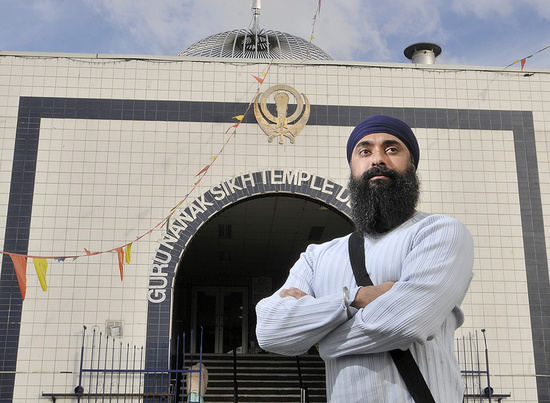 Many of the elements that make up this article have been featured in the Langar Hall in the past – Ranj Dhaliwal’s book Daaku about the lifestyle of Punjabi gangsters, thugs, and drug-dealers in BC during the late 1990s and early 2000s that cost the lives of 100+ youth in our community, Mani Amar’s film “A Warrior’s Religion” that documents the real life stories and effects of the peak of the violence, and finally to the various twists and turns that is British Columbia’s Sikh politics – from new coalitions to disputed certifications.
Many of the elements that make up this article have been featured in the Langar Hall in the past – Ranj Dhaliwal’s book Daaku about the lifestyle of Punjabi gangsters, thugs, and drug-dealers in BC during the late 1990s and early 2000s that cost the lives of 100+ youth in our community, Mani Amar’s film “A Warrior’s Religion” that documents the real life stories and effects of the peak of the violence, and finally to the various twists and turns that is British Columbia’s Sikh politics – from new coalitions to disputed certifications.
However, a recent article in The Walrus, author Timothy Taylor brings all these elements together in his piece, titled “Showdown on Scott Road.”
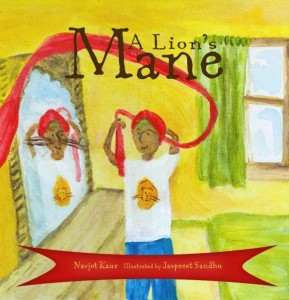 African American publishing houses were born out of a need – the need to fill a void in the industry. Bookshelves needed to share stories of their struggles and to give children a stake in their evolving identities. In turn, they gave rise to a new generation of diverse voices, with Asian-Pacific and Latino publishers following suit. They all have the same goal – to represent stories of their respective communities and give readers some authenticity and a sense of belonging. Now, consider this, how often did the covers of the books you read as a child have children who looked like you? Did these children’s books offer you a sense of belonging or importance? As our children enter into such a global community, it is clear that having access to authentic literature representing their heritage can only help ease the numerous challenges of peer pressure and to elevate self-esteem. Literature is perhaps the strongest avenue to enable us to realize our commonalities while teaching us about the idiosyncratic nature of one another.
African American publishing houses were born out of a need – the need to fill a void in the industry. Bookshelves needed to share stories of their struggles and to give children a stake in their evolving identities. In turn, they gave rise to a new generation of diverse voices, with Asian-Pacific and Latino publishers following suit. They all have the same goal – to represent stories of their respective communities and give readers some authenticity and a sense of belonging. Now, consider this, how often did the covers of the books you read as a child have children who looked like you? Did these children’s books offer you a sense of belonging or importance? As our children enter into such a global community, it is clear that having access to authentic literature representing their heritage can only help ease the numerous challenges of peer pressure and to elevate self-esteem. Literature is perhaps the strongest avenue to enable us to realize our commonalities while teaching us about the idiosyncratic nature of one another.
This is why we are so excited to bring you news about a new children’s book that promises to be “a staple on the shelves of young visionaries.” A Lion’s Mane, being released this month, is written by Navjot Kaur and illustrated by Jaspreet Sandhu. The book is published by Saffron Press, an independent publisher, aiming to encourage children to deepen their understanding of positive self-identity.
In this beautifully illustrated story, young readers journey to cultures around the world to explore the meaning of the dastaar, or turban of the Sikhs. Allusive words placed within a vibrant red dastaar help promote our connections as global citizens and encourage dialogue around issues of identity and kinship. [link]
This book certainly moves beyond the traditional in several ways. A Lion’s Mane brings a global perspective to the often misidentified image of the Sikh turban. It is printed on 100% recycled paper as well as displaying an Eco-Libris badge – 625 trees were planted for the first edition! In addition, a portion of proceeds from the sale of each book will support Seva Canada’s work to restore sight and prevent blindness in children. By shopping at Saffron Press, you really will be contributing to a green and ethical experience! We spoke with the author, Navjot Kaur, about the book and the challenges she underwent to have this story published. After the jump is the book trailer and the author’s first interview. As you view the information, consider this – how important is diverse and multicultural literature on the shelves of every library and school? Did you or do your children have access to this type of literature?
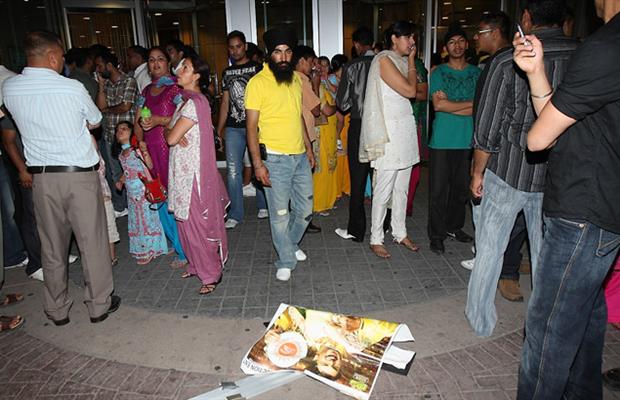 For diasporic Sikhs, it seems routine and almost expected to wake up to news about an incident where a Sikh was banned access to an event because of his or her kirpan. Many times, we blame this on the ignorance of law enforcement, who often have never heard of a kirpan. We tell ourselves, “Don’t worry, we just have to teach them and they’ll understand.” However, when Kirpan wearing patrons at a Gurdas Mann concert are barred entry, then we must stop for pause.
For diasporic Sikhs, it seems routine and almost expected to wake up to news about an incident where a Sikh was banned access to an event because of his or her kirpan. Many times, we blame this on the ignorance of law enforcement, who often have never heard of a kirpan. We tell ourselves, “Don’t worry, we just have to teach them and they’ll understand.” However, when Kirpan wearing patrons at a Gurdas Mann concert are barred entry, then we must stop for pause.
When a kirpan wearing citizen is blocked access from exercising their civil liberties, we as a community go into uproar mode. We file lawsuits, organize protests, and launch mass public marketing campaigns in order to exercise what we believe to an unalienable right and an articulation of our personal sovereignty. When a Bollywood movie comes out with a Sikh hero sans beard, our institutional bodies outrun and out-leap each other to be the first to cry foul. When a Baba in a Dera dresses up as Guru Gobind Singh Ji, we bring the state of Punjab to a halt.
However, at the point where cultural icon and repository Gurdas Mann, goes so far as to write “No Kirpans or Sharp Objects Allowed” on tickets being sold at a VAISAKHI show in England, then what do we do? We let him carry forward and WE outrun and out-leap each other so we can be first in line at his next concert.
Now when his concert bans an entity which is legally allowed in the public spaces of Canada, then what do we do? Do we ignore and slowly sweep this incident under the rug, like so many of our cultural problems? Or, do we stop and say, Hey, standing next to K.P.S Gill and lambasting “Sikh terrorism” is not ok; banning kirpans in UK is not appreciated; and throwing out concertgoers in Alberta, is simply no longer going to work.
One of the three Khalsa schools in Vancouver burnt to the ground yesterday. Arson is suspected. The fire started in 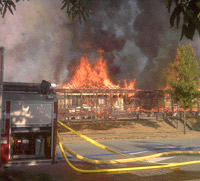 the main building and two portable classroom buildings simultaneously, and spread rapidly. The Elementary School had been broken into as well. When the school secretary called 911 to report the break-in, she saw smoke coming from one of the schools. The 911 operator told her to get out of the building and that firetrucks were on their way. [Globe and Mail]
the main building and two portable classroom buildings simultaneously, and spread rapidly. The Elementary School had been broken into as well. When the school secretary called 911 to report the break-in, she saw smoke coming from one of the schools. The 911 operator told her to get out of the building and that firetrucks were on their way. [Globe and Mail]
Firefighters brought the fire under control in 90 minutes, but of the 9 buildings that made up the Khalsa school, only one remains. They were able to save the Guru Granth Sahib Ji from the fire, making a touching scene when they carried it out to the sangat.
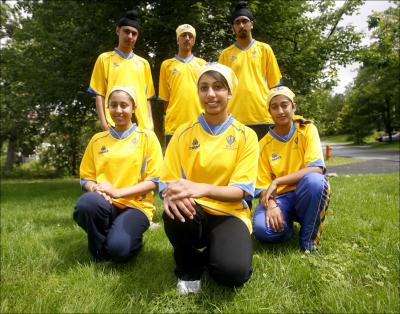
In order to provide a little bit of cheer as we head into the weekend, I thought I’d share this news bit.
A team of 32 Sikhs partnered to run across Canada, as well as fundraised $10,000, on behalf of children’s hospitals in Canada and in Africa. The runners were commemorating the 10th anniversary of a previous fundraising effort, and they hoped to expand the scope and reach of their efforts.
The runners belong to the Guru Gobind Singh Children’s Foundation, which did a fundraising run from Toronto to Ottawa 10 years ago. This year’s run is in honour of that effort, but on a much larger scale.
In addition to running legs of the race, the team had a van of supporters who provided nourishment and supplies. The runners were housed by Sikh families all across the country as they ran to Ontario, where the remainder of the relay was run by another team, in partnership.
“Barter” marriages are not uncommon. My grandfather’s generation did it in Punjab because it was wise to marry two sisters to two brothers; particularly, if the family was large or wealthy. My parents’ generation did it through the “middle-person” during family negotiations in an effort to bring more relatives abroad.
What is uncommon in our generation is that “bartering” is very upfront. It is included in matrimonial ads along with height, skin complexion, and age.
Raveena Aulakh reports for the Toronto Star that some families abroad are pressured and guilted by relatives in India to figure out a way to bring their children to Canada. Siblings in Canada are accused of not wanting their nieces and nephews to have a good life. The only resort left is to run a matrimonial ad requesting a “barter” for their children or nieces/nephews in prominent Punjabi newspapers.
Aulakh writes about Jaspal Singh, a cab driver in Vancouver, who was guilted into running such an ad by his brother in India.
Finally, Singh agreed to place an ad for his own 21-year-old son and 20-year-old daughter in hopes someone, somewhere would reciprocate with Canadian matches for his niece and nephew in India.
It is not only a long shot, it is also unethical, Singh admits. He says he has told his kids he will not force them to do something they are not ready for and that weddings would take place only after they have met their prospective partners and are ready.
He has paid for the ads to run for four weeks. If things do not fall into place by then, Singh says he has no intention of following up with more ads. “How long can you do it? I will not force them to get married for the sake of it.”
Singh knows it will put a strain on his relationship with his brother, and is already dreading that conversation.
 Two articles over the weekend got me thinking. I’ll get to them soon enough. Be patient!
Two articles over the weekend got me thinking. I’ll get to them soon enough. Be patient!
The issues aren’t new. I remember back to the late 1990s, when the community here in the Bay Area was moving to build the new San Jose Gurdwara. The Evergreen community protested and raised the typical objections – traffic, architecture that doesn’t ‘fit’ into the community, and sometimes the ‘undesirable neighbors’ argument.
Wherever Sikhs try to build something, these three arguments follow. The latest case…..Southall?
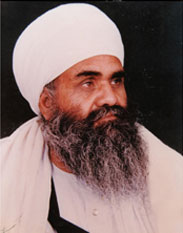 Earlier this week in B.C., hundreds of Sikhs protested the arrival of Mann Singh Pehowa, a granthi accused of rape, misconduct, and blasphemy.
Earlier this week in B.C., hundreds of Sikhs protested the arrival of Mann Singh Pehowa, a granthi accused of rape, misconduct, and blasphemy.
There is, of course, an underlying issue here regarding whether or not Pehowa supports his own dera, has encouraged blasphemy, etc. There is pretty widespread criticism of him, as an individual, as well as of his behavior. I do not want to use this opportunity to get into the nitty gritty of deras and blasphemy, but rather, to focus on the issue of religion and exploitation.
Earlier in the year, Sundari discussed sexual assault in the context of a larger community-level failure to ensure gender equity. Sexual abuse is not new to faith communities, but it evokes jarring feelings of betrayal, condemnation, and deep psychological trauma, both among those who are abused and among their loved ones.
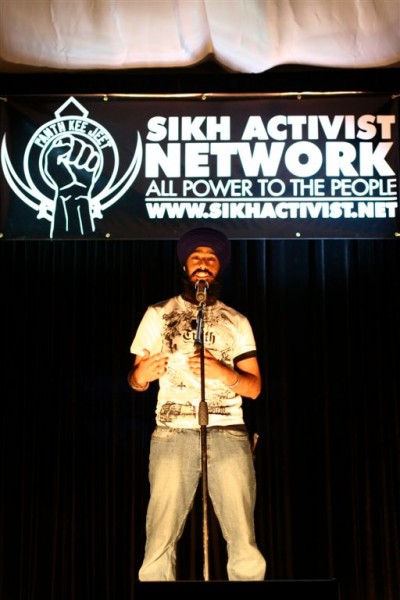
It is often said that a revolution begins not with the sword but with the pen. However, last Friday night in a packed banquet hall in the Toronto suburb of Malton, I witnessed a revolution begin with the microphone.
At an event entitled “When Lions Roar”, fantastically organized by the Sikh Activist Network, one young artist after another got on to the mike and paid homage to the lives destroyed in 1984. I was blown away by the talent and passion displayed by the performers. Through the art of spoken word, music, and action, each of the 26 acts put a different face on the impact of June 1984. They were all unique in their perspective, but all shared one common thread: 1984 is just too important to forget.
Over 1000 people gathered to attend the 4+ hour event. They covered the entire spectrum of Sikh life. This was not your typical retreat and kirtan crowd. In fact, the diversity of performers and audience has challenged me to rethink my stereotypes about who cares about 1984 and the future of the Sikh panth. Individuals that I would have never suspected of having even a passing interest in Sikhi or the Sikh community, would come up to the mike and speak with such energy, insight and emotion. They often reduced me to tears. And most amazing was the fact that almost all of them weren’t even alive in June 1984.
For a thirty-something guy like me who has always considered myself part of the “youth”, it was indeed a little bit humbling to realize that, while I’d probably still be the youngest guy at a Youth Akali Dal meeting, I’m now probably a generation or two above the youngest Sikh leaders. Which means me and my fellow Generation X-ers need to spend less time trying to do it all ourselves, and more time using our resources to enable the next wave of younger Sikhs to establish their own voice and institutions. We were the first generation coming through the diaspora, with little support from our elders. However, we can make it easier on our younger brothers and sisters. We can provide them seed funding to start their dreams, connect them those that can help them along the path, and help coach them through their challenges.
As you’ll see from the videos and photos, the next generation has indeed stepped up, their language of change is hip-hop and I think they’re gonna be alright.
Click through for videos and pictures.
He locked the washroom door, unravelled the nine-metre turban, took a pair of scissors and started cutting. Ten minutes later, three feet of hair lay in a pile and Charanbir Singh sat down and cried.
Outside, his parents and grandmother were in tears. Two friends persuaded him to come out, but Charanbir, his head wrapped in a towel, rushed to his room.
That was a year ago. Charanbir, now 17, still shudders at the memory. “I had to cut my hair.” (Link)
One of ironies of life in the 21st century western world is that despite an unparalleled degree of freedom of religion, the majority of people seem to be opting for freedom from religion.
Last week, Raveena Aulakh, a reporter from the Toronto Star, put a Canadian twist on the worldwide issue of apostasy amongst Sikh Youth.
Sikhism dates back to 15th-century India. Adherents are required to not cut their hair, considered a visible testament to their connection with their creator. The turban was adopted to manage long hair and make Sikhs easily identifiable.
For many young men in Greater Toronto, that is the problem: They don’t want to stand out.
Like other new or second-generation immigrants, many Sikh youngsters are desperate to fit in with the school crowd, while others complain of racism because they wear the turban. Add to that cultural influences, peer pressure and the desire to assimilate.
The end result? Many youngsters cut their hair, leading to family friction and, in some cases, lasting estrangement.
As a counterpoint, in the article and video above, Pardeep Singh Nagra (of boxing fame) presents his thoughts on why he’s decided to keep his hair.
Fear & Guilt
I’ve often wondered why so many Sikh youth keep their hair through high school but cut it as soon as they feel free from their parent’s control? From my perspective I see this as symptomatic of a great challenge facing Sikhs around the world today. Somehow, someway, we have fallen into the trap of pushing Sikhi to the next generation with fear and guilt, rather than sharing Sikhi through love.
Take your typical Sikh family; actually take mine. My now 25 year old cousin in Punjab had wanted to cut his hair since he was a teenager but two things stopped him. He was afraid that if he cut his hair his dad would beat him and then disown him. Secondly, he knew that if he did get a haircut and shave he wouldn’t be able to look his crying mom in the eye.
Unfortunately, there was little positive reinforcement around Sikhi in his life. Sure there was Sikhi by osmosis: visiting Gurdwaras, gurbani playing in the background, the odd sakhi told by our visiting grandfather. However, my cousin had little exposure to the aspects of Sikhi (nitnem, kirtan, seva, simran) that would have connected him with his faith on a deeper level. Most of the discussions with his parents were a flavour of the famous Goodness Gracious Me clip. So not surprisingly, upon entering college, he too cut his hair. And sure enough, he became our family’s black sheep, making a kid with already low self-esteem, feel even worse.
 For those that follow The Langar Hall, Ruby Dhalla is no stranger to our coverage on Canadian politics. Whether it be on our list of Sikh MPs throughout the world, a Sikh Barack Obama, a horrible beating that is symptomatic of the nightmare that is the Punjab Police, or even attendance at NRI Punjabi conference, she has found mention.
For those that follow The Langar Hall, Ruby Dhalla is no stranger to our coverage on Canadian politics. Whether it be on our list of Sikh MPs throughout the world, a Sikh Barack Obama, a horrible beating that is symptomatic of the nightmare that is the Punjab Police, or even attendance at NRI Punjabi conference, she has found mention.
In this post, she becomes the focus. Since last week after the Star published a story, Ruby Dhalla, the Liberal Member of Parliament, representing Brampton-Springdale, has been on the receiving end of a flood of media criticism for the following allegations
[Immigrant home care-givers] claimed that they earned $250 a week working 12- to 16-hour days at the Dhalla family home, that Dhalla herself had seized their passports and that other family members made them wash cars, shovel snow and clean chiropractic clinics owned by the family. [link]
The Canadian press has had a field day and has likened the case to the controversy that led to Eliot Spitzer’s resignation as the governor of New York due to his relationship with a prostitute after being seen as a ‘moralizer.’ Ruby Dhalla has been known to champion immigrant rights issues and women and thus it is for this reason that the allegations have been such damning.
It seems like Canada is showcasing one socially conscious Sikh rapper after another. TLH has covered “Humble The Poet” and now here is “Sikh Knowledge” from Montreal. Sikh Knowledge raps with Lotus on issues effecting the 2nd generation and marginalized peoples.
Kanwar Anit Singh Saini, a.k.a. Sikh Knowledge, is the son of Punjabi Sikh immigrants. He works in the field of speech pathology where he contributes his musical knowledge to the health sciences field.
Check out his songs below and let us know what you think!
Disclaimer: There are graphic descriptions and swear words in the videos below.
Its been a good year so far for Sikhs and Canadian sports. First, we’ve had NHL regular season and playoff games broadcast in Punjabi. We’ve also the first NBA game broadcast in Punjabi. And this year, at the annual Vaisakhi game for the Toronto Raptors, four good looking Sardars sang the Canadian and American national anthems. Performing on drums is Jiwanjot Singh Gill, on dilruba Harman Singh, on dhol is “Tabla Guy“, Gurpreet Singh Chana, and on vocals and harmonium, Dr. Onkar Singh.
Updated: Friday, at 11:30PM
Last year we covered the story of a Sikh youth accused of brandishing his kirpan on the schoolyard. Accounts of the incident were hugely divergent; it was unclear whether an assault had ever actually occurred, or whether the report was a feature of animosity toward religious minorities in Quebec.
Yesterday that youth was fully acquitted of the kirpan-based charge, and his other possible charges were dispensed. The outcome of this case is a success for the youth involved, but also in that its outcome has no bearing on the interpretation or application of its effect to the kirpan in general. The judge in this case intimated that the case had gone too far and would never have been brought, were it not for the youth’s nationality and religious identity:
UPDATE: The 13-year old youth who was arrested that night has been charged with assault and is scheduled to appear in court on May 19. [source] Thanks to everyone who’s given more information in the comments!
———————————————————————————————————————————–
Some tragic news is coming out of Toronto tonight from the Dixie gurdwara’s Vaisakhi celebrations. 
A Mississauga teen was stabbed in the stomach and seriously injured Tuesday night during a [Vaisakhi] celebration at the Ontario Khalsa Darbar temple in Mississauga.
The 15-year-old male was taken to the Hospital for Sick Children in Toronto after the stabbing at around 10 p.m. in a kitchen in the temple’s basement. The victim was conscious and breathing, a Peel police officer said at the scene, and was believed to be in serious but not life-threatening condition.
Peel police arrested a teenager at the scene who is about the same age as the victim.
The stabbing happened during Vaisaki, an annual religious festival marking the start of the new solar years that, throughout the day, draws about 30,000 people to the temple, also known as Dixie Gurdwara. [link]
An equally young suspect is in custody, though no information about motive has been released yet. If any readers in Toronto can update us, your southern neighbors would really appreciate it.
A suspect, about the same age as the victim, is in police custody. Police say the knife used in the stabbing may have been set out with some food. [link]
I’ll refrain from speculating about possible motives since there is so little information to go on right now. What I can say at this point, regardless of the back story, is that there is no acceptable justification for this senseless act of violence.
I’ll update this entry as more information is released though. Our thoughts are with the young victim, his family, and Toronto’s sangat.
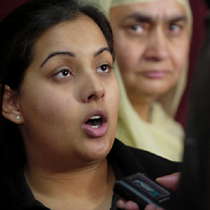
Tajinder (foreground) and Shalinder (background) Bansra.
Shalinder Kaur Basran is one of 19 recipients of the Carnegie Medal for heroism for intervening in a murderous domestic violence altercation in which a husband stabbed his wife. At the time, it was one of three cases in which desi-Canadian women had been killed by their families.
When Bibi Shalinder and her daughter heard a fight escalating downstairs, accompanied with cries for help, they ran downstairs where they found Jatinder Waraich had stabbed his wife, Navreet. She lay bleeding on the floor, crying for help. When he advanced on her, again, Bibi Shalinder forcibly removed him (while he held his knife) from the apartment while her daughter called 911. While police arrested Jatinder, his wife, unfortunately, did not survive his attack.
Reading about this award was really bittersweet for me. On one hand, I think interjecting yourself in the heat of a fight — with someone who’s already been acting crazy and is actively wielding a weapon — requires tremendous courage and strength. On the other hand, the underlying story of domestic violence and murder is heart-breaking. It made me wonder if others would have rushed to assist Navreet Waraich, or if they would have ignored it, assuming it was a domestic disagreement.

Canada’s problem with its Sikh minority should be of concern to Americans not just because Vancouver borders on the US, but for the broader lessons this story of ethnic conflict teaches. When a country imports an alien population, it often brings in all of the conflicts that bedeviled the immigrants in their homelands. Consequently, Western nations can get dragged into intractable conflicts that would otherwise be none of their business. Moreover, differences between the immigrant and host populations are likely to prove disruptive, even disastrous. Differences in history and culture pose difficulties enough, but most divisive are differences in nature. As long as we continue to ignore the possibility that there are biological differences among races that cause them to create different types of societies, we run the risk of importing populations that are prone to poverty and crime and hostile to white people and their values.
One could almost pity the plight of white supremacists these days. Their political influence has diminished greatly and their numbers are dwindling. A black man is the most powerful person in the world. Fearing public ostracization, they constantly have to ensure their words never betray their thoughts. In 2009, being a racist just isn’t cool anymore. But that hasn’t stopped this vocal minority from trying their best.
“White Pride” sites on the internet are full of rants against various ethnic and racial communities, blaming them for everything wrong with the world’s economic, social and political woes. Usually, its African Americans, Hispanics or Jews that are targeted. Now it looks like the Sikhs have caught their attention.
If Baldev Mutta’s cellphone rings in the middle of a meeting, he picks it up. If it beeps over dinnertime or at midnight, he answers it. And if he has to go out to pick up a woman and find her a spot at a shelter at 3 a.m., he will do it. “It can mean the difference between life and death for a woman,” said Mutta, executive director of Punjabi Community Health Services in Brampton. “They are abused and don’t have anywhere else to go. This agency is their lifeline.” [link]
The Punjabi Community Health Services is an organization based in Brampton, Canada which provides various services to Punjabi women who have been abused. Instead of waiting for women to turn up at their doorstep, this organization takes a proactive approach by sending workers into the community to speak with abused women. They visit Gurdwaras and community centers to find women in distress. At times they must speak with the women secretly at doctor’s appointments, grocery stores, even parking lots, so their families don’t find out.
::
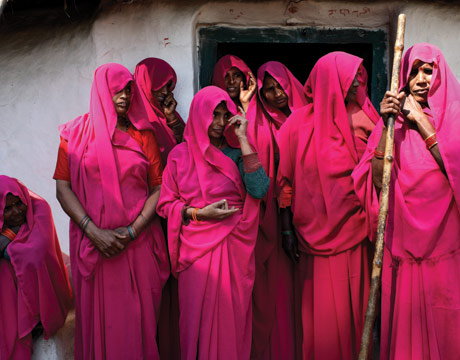 In related news, I recently read an article about the “Gulabi Gang” in an issue of Marie Claire which appeared on New America Media yesterday aswell. The Gulabi Gang are a group of women in India who have come together to fight against abuse. When local officials refused to take action against an alleged rapist, scores of pink-sari-clad women stormed the police station, demanding action – and thus, became know as the Gulabi Gang. For example, when Sampat Pal Devi learned that a friend had been beaten by her alcoholic husband and that the local police, chronically indifferent to violence against women, had looked the other way, something inside her snapped. In an effort to fight back, she gathered dozens of her female neighbors, armed them with sticks, and taught them how to fight back. Together, the self-declared Gulabi Gang have beaten up accused rapists, profligate officials, and husbands who’ve abandoned their wives.
In related news, I recently read an article about the “Gulabi Gang” in an issue of Marie Claire which appeared on New America Media yesterday aswell. The Gulabi Gang are a group of women in India who have come together to fight against abuse. When local officials refused to take action against an alleged rapist, scores of pink-sari-clad women stormed the police station, demanding action – and thus, became know as the Gulabi Gang. For example, when Sampat Pal Devi learned that a friend had been beaten by her alcoholic husband and that the local police, chronically indifferent to violence against women, had looked the other way, something inside her snapped. In an effort to fight back, she gathered dozens of her female neighbors, armed them with sticks, and taught them how to fight back. Together, the self-declared Gulabi Gang have beaten up accused rapists, profligate officials, and husbands who’ve abandoned their wives.
We’ve talked a little bit about the Sikh Youth Slate that ran for gurdwara elections — and won — in Surrey, as well as how mainstream Canadian media was framing the event. In that election, youth won the vote with a platform promising a focus on Sikhi, community-based service, and support for youth diversion activities (ie., building community space at the gurdwara so that adolescents didn’t get sucked into another world of criminal complexity).
What I didn’t know, at the time, was that shortly after the election, the outgoing gurdwara president filed a lawsuit challenging the process/legitimacy of the nominations for election (but not the election itself). A press release circulated today regarding the legal developments in the case, and as a non-Canadian, it is more than a little disorienting.
